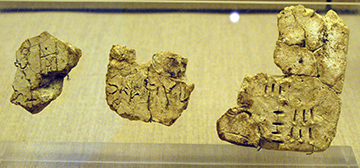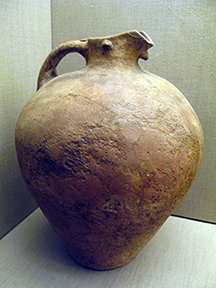
ARTH232  SPRING 2016 SPRING 2016  SCHEDULE SCHEDULE  REQUIREMENTS REQUIREMENTS
|
Minoan Crete
OUTLINE
|
 Sir Arthur Evans (1851-1941) named the Bronze Age civilization on the island of Crete "Minoan" after the legendary King Minos (son of Zeus and Europa). Among the ancient Greek mythological stories associated with the island the best known is that of Theseus and the Minotaur. Pasiphae, the wife of Minos, after having been made to fall in love with a beautiful bull, gave birth to the monstrous Minotaur (body of a man, head of a bull) who was confined to the labyrinth, built by the legendary craftsman Daedalus. There the Minotaur was fed seven youths and seven maidens sent each year from Athens as a tribute. The Greek hero Theseus joined the victims one year and succeeded in killing the Minotaur, with the assistance of Minos's daughter Ariadne and Daedalus. Ariadne left Crete with Theseus (to be later abandoned by him). Daedalus was imprisoned by Minos, but escaped with his son, Icarus, by flying away to Sicily on wings made of wax and feathers. Sir Arthur Evans (1851-1941) named the Bronze Age civilization on the island of Crete "Minoan" after the legendary King Minos (son of Zeus and Europa). Among the ancient Greek mythological stories associated with the island the best known is that of Theseus and the Minotaur. Pasiphae, the wife of Minos, after having been made to fall in love with a beautiful bull, gave birth to the monstrous Minotaur (body of a man, head of a bull) who was confined to the labyrinth, built by the legendary craftsman Daedalus. There the Minotaur was fed seven youths and seven maidens sent each year from Athens as a tribute. The Greek hero Theseus joined the victims one year and succeeded in killing the Minotaur, with the assistance of Minos's daughter Ariadne and Daedalus. Ariadne left Crete with Theseus (to be later abandoned by him). Daedalus was imprisoned by Minos, but escaped with his son, Icarus, by flying away to Sicily on wings made of wax and feathers.
Historical background
- Bronze Age civilization arrives in the Eastern Mediterranean from the more advanced East about 3000 BCE
- By 2000 BCE (MMI) the Minoan culture emerges on Crete and soon begins to flourish. Power and wealth were based in "royal palaces" at Knossos, Phaestos, and Mallia. There was extensive trading in Eastern Mediterranean, notably with Egypt. Crete exported timber, textiles, purple dye, wine, and oil. A form writing (Linear Script A) was developed.

Linear Script A, from Akrotiri (Thera)
(clay tablets)

Linear Script A
(clay tablets)
 
Jug with Linear A inscription, from Akrotiri (Thera)
1600-1700 BCE
- About 1700 BCE, the palaces were destroyed by earthquakes, and rebuilt on a grander scale (MMIII). Civilization continues to flourish down to about 1500 BCE.
- About 1500 BCE (LMI) begins the collapse of Minoan civilization (probably through a combination of earthquakes and raiding Mycenaeans from mainland Greece).
- By 1400 BCE (LMIII) Crete fell under the domination of the Mycenaeans.
VOCABULARY
- Sir Arthur Evans
- Helladic (pre-Hellenic)
- Kamares Style (2000-1700 BCE.)
- Marine Style (1500-1450 BCE.)
- Faience (earthenware made of coarse clay and covered with an opaque glaze)
- Minos
- Knossos
- Minotaur
- Daedalus
- Ariadne
- Bronze Age
- Linear A
- Linear B
- Michael Ventris
- pithos (pithoi)
- post-and-lintel
- pillow capitals
- Aghia Triadha
- sarcophagus
- Spyridon Marinatos
- Thera (Santorini)
- Akrotiri
SUGGESTED FURTHER READING
- Ann Brown, Arthur Evans and the Palace of Minos, Oxford: Ashmolean
Museum, 1983
- Ronald M. Burrows, The Discoveries in Crete, London: John Murray,
1908
- Rodney Castledon, Minoans: Life in Bronze Age Crete, London and New
York: Routledge, 1990
- Oliver Dickinson, The Aegean Bronze Age, Cambridge: Cambridge University Press, 1994
Arthur Evans, The Palace of Minos, 4 vols., London: Macmillan,
1921-1935
- Reynold Higgins, The Archaeology of Minoan Crete, New York, 1973
- Reynold Higgins, Minoan and Mycenaean Art, Oxford: Oxford University Press, 1981 (first published 1967)
- Sylvia Horowitz, The Find of a Lifetime: Sir Arthur Evans and the Discovery
of Knossos, New York: Viking Press, 1981
- Sara A. Immerwahr, Aegean Painting in the Bronze Age, University Park
and London: The Pennsylvania State University Press, 1990
- Bogdan Rutkowski, The Cult Places of the Aegean, New Haven: Yale
University Press, 1986
- R. F. Willets, Cretan Cults and Festivals, London: Routledge and Kegan
Paul, 1962.
- Hans Georg Wunderlich, The Secret of Crete, translated from the German by Richard Winston, New York: Macmillan, 1974
|
|
|
|
© Christopher L. C. E. Witcombe
|

 SPRING 2016
SPRING 2016  SCHEDULE
SCHEDULE  REQUIREMENTS
REQUIREMENTS

 SPRING 2016
SPRING 2016  SCHEDULE
SCHEDULE  REQUIREMENTS
REQUIREMENTS